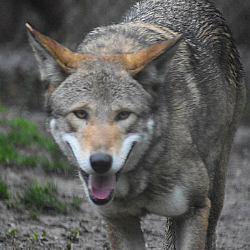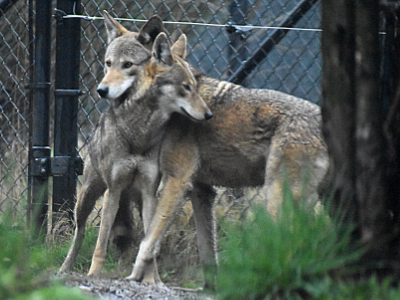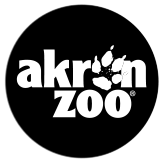Throughout time and in many cultures, wolves have been a symbol of loyalty, family, teamwork and guardianship. But who is the guardian of our wolves, and “howl” are their populations doing? Though some populations of wolves are stable and in good health, other populations, such as the red wolf population, are considered critically endangered.
 Red wolves are apex predators, meaning they are at the top of the food chain. However, throughout history their numbers have still been heavily impacted by habitat loss, extreme predator control programs and human-animal conflict. In fact, in 1980, the red wolf population was so heavily impacted, they were declared extinct in the wild. Fortunately, the US Fish and Wildlife Service saw this decline coming, and they were able to begin a red wolf breeding program in human care. Seventeen individual wolves were gathered for the program, 14 of whom successfully bred and produced healthy pups. In 1987, the species was returned to a portion of its native range in Alligator River National Wildlife Refuge. The population grew, and select zoo-born pups were also placed with litters in their native habitat as part of the reintroduction program.
Red wolves are apex predators, meaning they are at the top of the food chain. However, throughout history their numbers have still been heavily impacted by habitat loss, extreme predator control programs and human-animal conflict. In fact, in 1980, the red wolf population was so heavily impacted, they were declared extinct in the wild. Fortunately, the US Fish and Wildlife Service saw this decline coming, and they were able to begin a red wolf breeding program in human care. Seventeen individual wolves were gathered for the program, 14 of whom successfully bred and produced healthy pups. In 1987, the species was returned to a portion of its native range in Alligator River National Wildlife Refuge. The population grew, and select zoo-born pups were also placed with litters in their native habitat as part of the reintroduction program.
Unfortunately, since 2018, the land for red wolf recovery has been reduced by nearly 90 percent, captive-to-wild release events (like those used by the recovery program) have been prohibited, and protections for any red wolves that wander away from the designated recovery area have been eliminated, allowing anyone to kill red wolves on private lands for any reason. Today, as few as 20 individuals can be found in the wild. In order to save this species, it is essential that we take conservation action and raise awareness for their protection.
Your Akron Zoo is home to two red wolves, Juno and Waya, who were introduced earlier this year. This species is one of many added to the Akron Zoo since 2012, in addition to Speke’s gazelles, octopus, naked mole rats, tree monitors, snowy owls, red breasted geese, musk deer and grizzly bears, just to name a few.
Waya and Juno are members of the Red Wolf Species Survival Plan, or SSP, which helps maintain a healthy and genetically diverse population in zoos and matches compatible animals in breeding pairs. This SSP is especially important because someday we hope to reintroduce these animals to their native habitat, so it is important to maintain genetic diversity and prevent health complications that could affect the native population. Red wolves are also members of the AZA SAFE program, which is an initiative supported by the Association of Zoos and Aquariums. “SAFE” stands for Saving Animals From Extinction. This program prioritizes collaboration between AZA institutions focused on conservation of this species and implements strategic conservation initiatives.
 As an informal science learning center and an accredited member of the AZA, your Akron Zoo provides unique learning opportunities for children and families that focus on endangered species and conservation programs. Our red wolf habitat, for example, is designed to teach our 400,000 annual guests the differences between red wolves and coyotes. Humans are one of the top threats to red wolves, since they are often mistaken for coyotes and killed. By highlighting the key differences, our guests are learning practical knowledge that can be used to aid in conservation.
As an informal science learning center and an accredited member of the AZA, your Akron Zoo provides unique learning opportunities for children and families that focus on endangered species and conservation programs. Our red wolf habitat, for example, is designed to teach our 400,000 annual guests the differences between red wolves and coyotes. Humans are one of the top threats to red wolves, since they are often mistaken for coyotes and killed. By highlighting the key differences, our guests are learning practical knowledge that can be used to aid in conservation.
Since our hope is to someday reintroduce our wolves to their natural habitat, we try to encourage natural behaviors and instincts at the Akron Zoo. Unlike many of our other animals, we do not train our wolves because we want to minimize their human interaction. Additionally, any enrichment they receive is natural, like scented mulch, instead of man-made items like some of our other animals get.
The Akron Zoo helps to save endangered species like the red wolf from extinction by participating in 46 species survival plans and 21 conservation and recovery projects. You can help us support red wolves by donating to the Akron Zoo’s Animal Fund, or by giving directly to our conservation partners, the Red Wolf Coalition. The Red Wolf Coalition is an advocacy group fighting for the continuation of the red wolf reintroduction program. You can also support our animals by attending annual events such as Howl-O-Ween, which takes place every Saturday and Sunday throughout the month of October. A portion of the revenue from ticket sales helps us care for animals in our park and around the world!
And remember, the Akron Zoo will once again be on the ballot this November. With your help to pass the levy, your Zoo will continue to provide outstanding animal care, engaging educational programs and exciting habitats for all of our animals, including the endangered species who need your help. Thank you for your continued support and we hope to see you soon!
